Inorganic compounds Study guides, Class notes & Summaries
Looking for the best study guides, study notes and summaries about Inorganic compounds? On this page you'll find 1970 study documents about Inorganic compounds.
Page 3 out of 1.970 results
Sort by
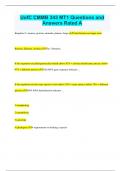
-
UofC CMMB 343 MT1 Questions and Answers Rated A
- Exam (elaborations) • 53 pages • 2024
-
- $11.49
- + learn more
UofC CMMB 343 MT1 Questions and Answers Rated A Kingdom (5: monera, protista, animalia, plantae, fungi) Classification no longer used Bacteria, Eukarya, Archaea The 3 domains If the organisms are phylogenetically related (above 97% = closely related/same species; below 97% = different species) 16S rRNA gene sequence indicates ... If the organisms are the same species or not (above 70% = same species; below 70% = different species) DNA-DNA hybridization indicates ... 1) morphology 2) metaboli...
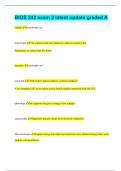
-
BIOS 242 exam 2 latest update graded A
- Exam (elaborations) • 25 pages • 2023
- Available in package deal
-
- $9.99
- + learn more
BIOS 242 exam 2 latest update graded A organic heterotrophs are? heterotroph •An organism that must obtain its carbon in organic form •Dependent on eating other life forms inorganic autotrophs are? autotroph •"Self-feeder" (photosynthesis or chemosynthesis) •Uses inorganic CO2 as its carbon source; builds organiccompounds from the CO2 phototroph an organism that gets its energy from sunlight chemotrophs Organisms that get energy from chemical compounds Photoautotrophs Capture ene...

-
Unit 8 Knewton Exam Questions And Correct Answers(2024/2025)
- Exam (elaborations) • 11 pages • 2024
-
- $9.49
- + learn more
Unit 8 Knewton Exam Questions With Verified Answers. Which of the following statements are true about organic compounds versus inorganic compounds? Select all that apply: The melting points of organic compounds are usually lower than those of inorganic compounds. The boiling points of organic compounds are usually lower than those of inorganic compounds. The flammability of organic compounds is usually lower than that of inorganic compounds. The bond type of organic compounds is more often ionic...
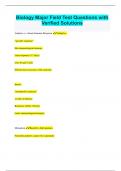
-
Biology Major Field Test Questions with Verified Solutions
- Exam (elaborations) • 67 pages • 2024
- Available in package deal
-
- $11.99
- + learn more
Biology Major Field Test Questions with Verified Solutions Adaptive vs. Innate Immune Response Adaptive - "specific response" Has immunological memory Later response (3-7 days) Uses B and T cells Effectiveness increases with exposure Innate- "nonspecific response" 1st line of defense Response within 12 hours Lacks immunological memory Mutualism Benefit to both partners Normally partners cannot live seperately Cooperation A beneficial but not obligate form of symbiosi...
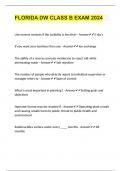
-
FLORIDA DW CLASS B EXAM 2024
- Exam (elaborations) • 17 pages • 2024
-
- $15.49
- + learn more
It's in the middle of the summer & you're having a breakdown in the coagulation process in your up-flow clarifier due to algae, this problem occurs only in the late afternoon with periods of good operation before and after. What changes should you make during the problem periods to improve the finish water quality? - AnswerReduce the sludge blanket depth The inorganic compounds (ie. Iron) are effectively removed from your raw water using aeration. Test indicate an increasing taste and odor ...
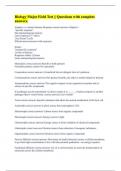
-
Biology Major Field Test || Questions with complete answers.
- Exam (elaborations) • 26 pages • 2024
- Available in package deal
-
- $14.69
- + learn more
Adaptive vs. Innate Immune Response correct answers Adaptive - "specific response" Has immunological memory Later response (3-7 days) Uses B and T cells Effectiveness increases with exposure Innate- "nonspecific response" 1st line of defense Response within 12 hours Lacks immunological memory Mutualism correct answers Benefit to both partners Normally partners cannot live seperately Cooperation correct answers A beneficial but not obligate form of symbiosis Commensali...
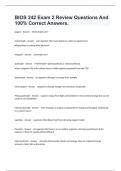
-
BIOS 242 Exam 2 Review Questions And 100% Correct Answers.
- Exam (elaborations) • 15 pages • 2024
-
Available in package deal
-
- $9.99
- + learn more
organic - Answer heterotrophs are? heterotroph - Answer •An organism that must obtain its carbon in organic form •Dependent on eating other life forms inorganic - Answer autotrophs are? autotroph - Answer •"Self-feeder" (photosynthesis or chemosynthesis) •Uses inorganic CO2 as its carbon source; builds organiccompounds from the CO2 phototroph - Answer an organism that gets its energy from sunlight chemotrophs - Answer Organisms that get energy from ch...
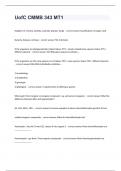
-
UofC CMMB 343 MT1 Questions with complete solution
- Exam (elaborations) • 32 pages • 2024
-
Available in package deal
-
- $13.99
- + learn more
UofC CMMB 343 MT1 Questions with complete solution UofC CMMB 343 MT1 Kingdom (5: monera, protista, animalia, plantae, fungi) - correct answer Classification no longer used Bacteria, Eukarya, Archaea - correct answer The 3 domains If the organisms are phylogenetically related (above 97% = closely related/same species; below 97% = different species) - correct answer 16S rRNA gene sequence indicates ... If the organisms are the same species or not (above 70% = same species; below 7...
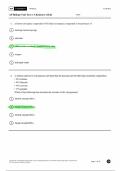
-
AP Biology Unit 1 Progress Check Chemistry of Life Key (North western university)
- Exam (elaborations) • 29 pages • 2023
-
- $21.49
- + learn more
AP Biology Unit Test 1: Chemistry of Life Name 1. A feature of organic compounds NOT found in inorganic compounds is the presence of @ ionizing chemical groups electrons @ oxygen @ hydrogen bonds 2. A student analyzed a viral genome and found that the genome had the following nucleotide composition. * 28% adenine * 20% thymine * 35% cytosine * 17% guanine ‘Which of the following best describes the structure of the viral genome? @ Double-stranded DNA @ Double-stranded RNA @ Single...
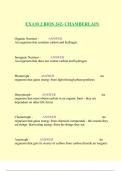
-
EXAM 2 BIOS 242- CHAMBERLAIN
- Exam (elaborations) • 21 pages • 2024
-
- $12.49
- + learn more
EXAM 2 BIOS 242- CHAMBERLAIN Organic Nutrient - ANSWER An organism that contains carbon and hydrogen Inorganic Nutrient - ANSWER An organism that does not contan carbon and hydrogen Phototroph - ANSWER An organism that gains energy from light through photosynthesis Heterotrop...

How much did you already spend on Stuvia? Imagine there are plenty more of you out there paying for study notes, but this time YOU are the seller. Ka-ching! Discover all about earning on Stuvia


